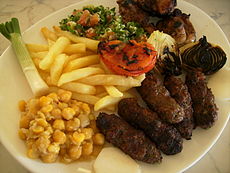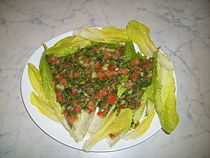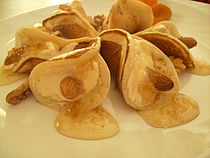Lebanese cuisine
This article has multiple issues. Please help improve it or discuss these issues on the talk page. (Learn how and when to remove these template messages)
|


Lebanese cuisine (Arabic: المطبخ اللبناني) (French: cuisine libanaise) includes an abundance of whole grain, fruits, vegetables, starches, fresh fish and seafood; animal fats are consumed sparingly. Poultry is eaten more often than red meat. When red meat is eaten it is usually lamb on the coast, and goat meat in the mountain regions. It also includes copious amounts of garlic and olive oil, often seasoned by lemon juice.[1] Olive oil, herbs, garlic and lemon are typical flavors found in the Lebanese diet.
The traditional alcoholic Arak (عرق), an anise-flavored liqueur, is the Lebanese national drink and usually served with a traditional convivial Lebanese meal. Another historic and traditional drink in Lebanon is wine (نبيذ).
However, in Lebanon some desserts are specifically prepared on special occasions: the meghli, for instance, is served to celebrate a newborn baby in the family.
History
The Lebanese cuisine is an ancient one and part of the Levantine cuisine. Many dishes in the Lebanese cuisine can be traced back thousands of years to Roman times, and to the roots and origins of the Levant and Mesopotamia civilizations, that is the Phoenicians. For most of its recent past, Lebanon has been ruled by foreign powers that have influenced the types of food the Lebanese ate. From 1516 to 1918, the Ottoman Turks controlled Lebanon and introduced a variety of foods that have become staples in the Lebanese diet, such as cooking with lamb.
After the Ottomans were defeated in World War I (1914–1918), France took control of Lebanon until 1943, when the country achieved its independence. This time, the French introduced foods such as flan, a caramel custard dessert dating back to the 16th century AD, and buttery croissants.
Background

Most often foods are grilled, baked or sautéed in olive oil; butter or cream is rarely used other than in a few desserts. Vegetables are often eaten raw, pickled or cooked. Herbs and spices are used and the freshness of ingredients is important. Like most Mediterranean countries, much of what the Lebanese eat is dictated by the seasons. Lebanese recipes are a rich mixture of a variety of ingredients that come from all the Lebanese regions, and each Lebanese area has its special dishes that reflects the culture of the area.
In Lebanon, very rarely are drinks served without being accompanied by food. Similar to the tapas of Spain, mezeluri of Romania and aperitivo of Italy, mezze is an array of small dishes placed before the guests creating an array of colors, flavors, textures and aromas. This style of serving food is less a part of family life than it is of entertaining and cafés. Mezze may be as simple as raw or pickled vegetables, hummus, baba ghanouj and bread, or it may become an entire meal consisting of grilled marinated seafood, skewered meats, a variety of cooked and raw salads and an arrangement of desserts.
Although simple fresh fruits are often served towards the end of a Lebanese meal, there is also dessert, such as baklava and coffee. Although baklava is the most internationally known dessert, there is a great variety of Lebanese desserts.
A typical mezze will consist of an elaborate variety of thirty hot and cold dishes and may include:
- Salads such as tabbouleh and fattoush, together with dip such as hummus, baba ghanoush or moutabal, and kebbeh.
- Some patties such as the Sambusac.
- Stuffed grape leaves
Family cuisine offers also a range of dishes, such as stews (or yakhneh), which can be cooked in many forms depending on the ingredients used and are usually served with meat and rice vermicelli.
Lebanese flat bread is a staple to every Lebanese meal and can be used in place of a fork.
Cuisine by Village
These recipes are attributed to these regions in Lebanon, although you find them now as main dishes at most Lebanese homes across the country with local variations.
- Ain-Zibdeh: Hareeseh (wheat and chicken)
- Baalbek: Safiha Baalbakieh (meat-stuffed puff pastry)
- Baino: Kebbe and Lahme bil-khal (meat mixed with crushed wheat and meat soaked in vinegar)
- Baskinta: Makhlouta (meat, rice, and nuts)
- Beirut: Samkeh Harra and Akhtabout (spicy fish and octopus), Roastuts
- Beit Chabab: Riz bi-Djaj (chicken with rice)
- Beit Mery: Kebbe Lakteen (pumpkin-flavoured meat)
- Beiteddine: Kafta Bithine (spiced meat with sesame concentrate)
- Broummana: Deleh Mehshi (stuffed rib cage of lamb)
- Bsharri: Koussa bil-Laban (meat and rice-stuffed zucchini cooked in yoghurt)
- Dhour El Choueir: Shish Barak (dough balls stuffed with ground beef and cooked in yoghurt)
- Douma: Laban Immo (cooked yoghurt and lamb with rice)
- Ehden: Kebbe Zghartweih (oven-cooked meat and crushed wheat blend)
- El Koura: Abu Shoushe (topinambur and lentils stew)
- Ferzol: Freikeh (cooked wheat with meat)
- Hammana: Fasoulya Hammanieh (kidney bean stew)
- Ihmej: Ghameh (stuffed cow intestines)
- Jbeil: Koussa and Wark Inab bil-Kastaletah (stuffed zucchini, grape vines and steak)
- Qalamoun: Fresh Carrot juice with ice cream inside
- Kfar meshki: Kebbe bil-Kishk (meat mixed with wheat and yoghurt)
- Marjayoun: Vine leaves with squash and grilled chicken
- Ras El Matn: Fatet (yoghurt, fried bread and nuts)
- Rashana: Mjadrat Fasoulya (lentils and kidney beans)
- Rashaya Al Wadi: Kebbe Heeleh (meatballs)
- Saghbeen: Zinkoul bil-Laban (meat filled pastry and yoghurt)
- Shouf: Fatet Batinjan (yoghurt, fried bread and aubergine) and mate
- Sidon: Riz bil-Foul (Rice and fava beans)
- Tripoli, Lebanon: Mjadrah and Fattoush (crushed lentils and salad)
- Tyre: Saiyadit al-Samak (rice and fish)
- Zahlé: Kebbe Zahleweieh (meat and crushed wheat blend)
Lebanese Dishes and Ingredients






- Ackawi – white cheese salty or not depending on choice. Usually used in Manaeesh (Lebanese-style pies)
- Adas Bil Hamod - Soup made out of Lentils and lemon juice.
- Baba ghanouj – a dip made of char-grilled aubergine (eggplant), tahina, olive oil, lemon juice, and garlic puree—served.
- Baklava – a dessert of layered filo pastry filled with nuts and steeped in Attar syrup (orange or rose water and sugar) or honey, usually cut in a triangular or diamond shape that originates in Lebanon.
- Roasted nuts – a mix of more than 20 kinds and flavors of kernels, mostly dry roasted.
- Balila – known as cumin chickpeas.
- Barout del batata – spicy lamb served with potatoes
- Batata harra – literally "spicy potatoes".
- Burghul Banadoura – bulgur and tomato
- Daoud Bacha – meatballs with tomato sauce
- Djaj Mechwi – grilled chicken with peas
- Fattoush – 'peasant' salad of tossed greens with pita bread, cucumbers, tomatoes, chickweed, and mint.
- Falafel – small deep-fried patties made of highly spiced ground chickpeas.
- Fried cauliflower
- Fried eggplant
- Fatayer – a turnover pastry, often made with sbanegh (spinach)
- Fuul (vicia faba) slow cooked mash of brown beans and red lentils dressed with lemon, olive oil and cumin.
- Halva – sesame paste sweet, usually made in a slab and studded with fruit and nuts.
- Hummus – dip or spread made of blended chickpeas, sesame tahini, lemon juice, and garlic, and typically eaten with pita bread.
- Kunafi – either shoelace pastry dessert stuffed with sweet white cheese, nuts and syrup, or more commonly the version with semolina pastry served on a sesame seed bun with sweet sugar syrup (very popular for breakfast) made with " angel hair" butter and pistachios or nuts. Generally these can be found in sweet shops, as well as bigger bakeries.
- Kibbeh – Finely minced meat mixed with Bulgur (cracked Wheat) that can be made in different forms including stuffed with ground meat/onions: layered pan baked, fried balls/patties and/or cooked in yogurt, or eaten raw.
- Kibbeh nayyeh – raw kibbeh: finely minced meat mixed with Bulgur (cracked Wheat) and eaten like steak tartar.
- Kafta – Paties, fingers, stars or a flat cake of minced meat, onions, parsly, and spices that can be baked or charcoal-grilled on skewers.
- Kousa Mahshi – [zucchini]] (many varieties are used) stuffed with meat and rice.
- Kubideh – served with pivaz (a mix of minced parsley, onions, ground cumin and sumac).
- Labneh – strained yogurt cheese, spreadable and garnished with good olive oil and sea salt.
- Znood Es-sett – filo pastry cigars with various fillings.
- Lahm bil ajĩn – a pastry covered with minced meat, onions, and nuts.
- Ma'amoul – stuffed cookies made from semolina with date, pistachio or walnut filled and shaped in a wooden mould called a tabi made specially for Christian (traditionally Easter) and Muslim holidays (such as Ramadan).
- Mfaraket Koussa – spicy zucchini
- Makdous – stuffed eggplant (usually with nuts) in olive oil.
- Manaeesh – Mini pizzas (usually folded) that are made in any number of local bakeries or Furns, traditionally garnished with cheese, Za'atar, spicy diced tomatoes, kashk in its Lebanese version, or minced meat and onions. Some bakeries allow you to bring your own toppings and build your own or buy the ones they sell there. Breakfast, lunch and dinner. (Lebanese style pies)
- Mujaddara (imjaddarra) – cooked lentils together with wheat or rice, garnished with onions that have been sauteed in vegetable oil.
- Mulukhiyah – A stew with Mulukhiya (Nalta/Tossa Jute) leaves, chicken, beef, and in the Lebanese fashion, topped with raw chopped onions soaked in vinegar, served over rice. It sometimes has toasted pita chips under the rice.
- Mutabbel – a mix of slow cooked eggplant and tahini.
- Pastirma – Tender cooked meat, usually served with vegetables.
- Qatayef – a sort of sweet dumpling filled with cream or nuts.
- Qawarma – chopped lamb, salted and kept in the grease of the animal
- Samkeh Harra – grilled fish that has been marinated with chili, citrus, and cilantro
- Shanklish – aged cheese balls
- Shawarma – a sandwich with marinated meat (either lamb or chicken) that is skewered on big rods and cooked slowly, then shaved and placed in a 10-inch pita roll with pickles, tomatoes, and other tangy condiments.
- Shish taouk – grilled chicken skewers that utilize only white meat, marinated in olive oil, lemon, parsley, and sumac.
- Siyyadiyeh – delicately spiced fish served on a bed of rice. Fish cooked in saffron and served on rice with onions, sumac, and a tahini sauce (the most important part of the dish) originated in the southern areas of Lebanon.
- Tabbouleh – minced/chopped parsley salad with burghul (cracked wheat), tomatoes, onions, and mint.
- Tahini – sesame paste
- Toum – garlic sauce
- Wara' Enab – grape leaves stuffed normally with meat and rice or made lenten style with just rice with lemon sauce.
- Za'atar – dried ground thyme, sesame seeds and sumac that can differ from region to region and from family to family. Most are made in house, but can be bought at Lebanese larders.
- Lebanese "Seven Spice" Blend – a mixture of equal parts of allspice, black pepper, cinnamon, cloves, fenugreek, nutmeg and ginger. It is commonly used to flavor many Lebanese dishes.
Lebanese Sweets

- Pastries such as baklava, Kaak, Sfouf and Maamoul.
- Lebanese ice cream with its oriental flavors (Amar el Din made from dried apricots; fresh fruits; pistachios).
- Lebanese roasted nuts with variety and mixes.
Lebanese Beverages
- Beer, alcoholic beverage
- Arak, alcoholic beverage
- Ayran, yogurt
- Château Musar, Lebanese winery in Ghazir, Lebanon
- Jallab, sweet drink
- Château Ksara, famous wine from Beqaa Valley, founded in 1857 by Jesuit Priests
- Lebanese wine
- Le caroubier, non-alcoholic beverage made from carob
- Turkish coffee
- Mate in Shouf and Aley.
- White coffee
- Arabic coffee qahwa sada (plain coffee) is plain and more bitter, although it originates in Greater Syria.
List of Lebanese wines
- Domaine de Baal
- Ksara
- Msaya
- Château Musar
- Château Kefraya
- Château Héritage
- Château Faqra
- Château Nakad in Jdita
- Domaine des Tourelles
- Château St Thomas
- Cave Kouroum
- Clos de Cana
- Nabise Mont Liban
- Château Qanafar
- Château Khoury
- Couvent St. Sauveur
-
Almaza beer
-
Bottle of Château Musar 1999
-
The wine making headquarters of Château Ksara, in Bekaa, Lebanon
-
Visitors at the chateau, on a wine-tasting visit.
Lebanese Coffee
The coffee served in Lebanon is sometimes a variation of Turkish coffee, but a dark type of coffee is the main type served.
See also
- Cypriot cuisine
- Armenian cuisine
- Greek cuisine
- Levantine cuisine
- Mediterranean cuisine
- Middle Eastern cuisine
- Ottoman cuisine
- Syrian cuisine
- Turkish cuisine
- Iraqi cuisine
- Arab cuisine
- Jordanian cuisine
References
External links



